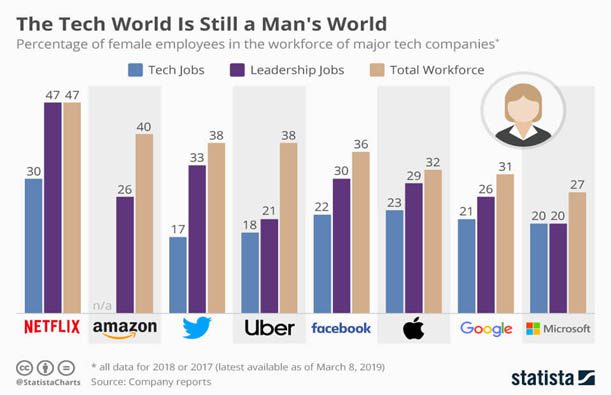Building the Future of Women in Data Science
Microsoft claims to be an equal opportunity employer with emphasis on equal pay and equal representation. However, women are still 27.6% of their tech workforce. Clearly, high rhetoric isn’t being executed. This is true for most companies out there. While women are 48% of the overall workforce, they form only 20% of tech, and only 31% of data science.
There must be a systematic problem that’s leading to such consistently one-sided results. In this note, explore how the rules of the game are lopsided for women in data science, and what can be done to fix it.
It’s a woman’s world out there
The following graph will shed more light on the gender-distribution of some major tech companies.

Truly disheartening numbers.
Things are being done to balance these numbers, albeit slowly.
But why is it that we’ve reached a new decade, but this journey to equality is still in progress? A few broad reasons:
Early conditioning
The seed of inequality is (un)knowingly planted very early in most cases. Subtle childhood patterns and interests are what go on to become the person’s interests and desires.
For example, when one is bringing toys for a baby boy, one would normally pick from either a dinosaur, a puzzle, cars, toy guns, etc. In contrast, girls are gifted with dresses, kitchen sets, coloring books, barbies, soft toys, etc. These little cues shape self-identity in subtle but powerful ways.
This conditioning can be bypassed if the child is exposed to a wide range of role models from a variety of fields. Inspiring figures like Williamina Fleming (the women who cracked the secrets of the universe with computation), Grace Hopper (aka ‘the mother of computing’), Adele Goldberg (the inspiration behind Steve Jobs’ first Apple computer), and more can serve as a reminder to girls that women have been a crucial part of tech since a long time, and they can continue to be so.
As a result of the underrepresentation in tech, there are fewer women stepping up, which worsens the underrepresentation. A perfect catch-22.
The solution to this is simple: increasing awareness when the time is right. This can’t be changed in retrospect, but it is nonetheless an important point to talk about.
A pressure to step back
This pressure arises in the form of gender-stereotyped expectations.
Traditionally, it is the female who is the caretaker of the family. Even though she may be working, she is the one expected to tend to the sick elderly or children. She is the one expected to sacrifice her career for the well-being of the family. Society does it and as a result, the woman herself does it, too.
Motherhood and maternity leave are another reason. Women are offered maternal leave but there is no guaranteed paternal leave for the father.
Instead of being a support system, familial ties and the related expectations hinder women from progressing forward.
Gender pay gap
Gender pay gap is very real, and like the other rules – lopsided. A few points to consider while discussing the gender pay gap and its consequences:
- Women are afraid or hesitant to ask for raises, negotiate salaries, or push for more. This is because of the perception that a woman aggressively pushing for money is greedy. A male in the same position would be seen as an ambitious individual, doing a very naturally self-respectful thing.
- Discussing and comparing salaries is looked down upon – not only in homes, but in workplaces even. People rarely discuss their salaries or ask promoted employees of the raises they got. This leads to women not knowing the salaries of their male colleagues, thereby keeping the issue under the carpet.
- Finally, questions about previous salaries can affect the new one offered. If a woman was underpaid at her previous company and she honestly shares the figure, new employers are also likely to offer less than the deserving amount.
Future reimagined: how to bring change
Although not quick fixes, the following steps can help in turning the tide in favor of women and increase their numbers in the data science workforce.
By imparting STEM education informally
The onus for this falls largely on the parent. Whether you belong to a STEM-related field or not, it is imperative that you expose your child to all that is available in the world so they can follow their curiosity and develop unique interests.
Eventually, children do find a burning passion or area of interest (probably in school) be it science-fiction, botany, or trigonometry. The crucial thing is to encourage these interests and not lump them into genders, thus unknowingly closeting the child.
Encourage them to try everything there is no matter which field it belongs to. Couple this with knowledge about role models and luminaries who made contributions to the field, especially females. You can find these examples in a remote Pakistani village (like Malala) or right at home (like Michelle Obama). Expose them to their stories, journeys, determination and see what path the child starts envisioning for themselves.
By equalizing pay
This will create significant change whose ripple effects we can’t even logically grasp.
And it has already begun – there are companies who are walking the walk. Case in point, Salesforce. Keeping equality at their core, Salesforce is evidently working on an equal pay model, and are doing a phenomenal job so far.
If you’re an employer, do away with asking ‘how much were you previously paid?’ A candidate’s experience, skillset, earnestness, and attitude should determine their role and remuneration. Focus on getting an accurate picture of this and take a judgment call on the perception formed.
If you are a woman leader/ manager, create opportunities for promotion and leadership in your team. Bring in speakers and inspiring figures to encourage your female workforce to give their best shot. Introduce paternal leave if it isn’t there and tighten up harassment policies so that no woman is subjugated at the hands of misogynistic males.
By creating communities
Finally, if we want women to step up and become fluent leaders in data science, we need to create safe, educational spaces for them to do so.
Programs like Girls Who Code, Black Girls Code, TechGirlz, R Ladies, Py Ladies, and Women in Technology all aim to educate women and create a space for them to learn, grow, network, and establish roots for success in this field.
The ones who are starting can land internships, while the ones further up the road can seek higher positions in other firms.
Consistently implemented, the above 3 methods have the power to slowly but surely attract and retain more women in the data science field.
Let’s start with community
We believe in the revolutionary power of data and the revolutionary power of women. Combined, who knows the revolution that can unleash? Join us for one of the data science cohorts set to happen once we step out from the lockdown!

